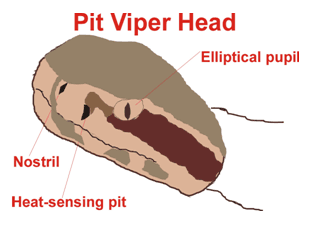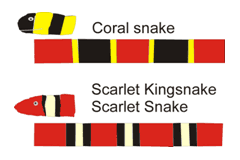FAQ's - Select question to reveal answer. Expand all | Collapse all
How many species of snakes are there in
South Carolina? How many are venomous?
There are 38 species of snakes in South Carolina, but only six species
are venomous. It is far more common for people to encounter a non-venomous species than a venomous one. All
snakes are nonaggressive when left alone. The six venomous species are the coral snake, pigmy rattlesnake,
cottonmouth (aka water moccasin), copperhead, canebrake or timber rattlesnake, and the eastern diamondback
rattlesnake. Of these six species only two occur statewide (canebrake/timber rattlesnake and copperhead), and
just three are considered to be common in their ranges (copperhead, (cottonmouth, water moccasin), and timber
rattlesnake).
Are there any visual clues I can look for
on a snake to determine if it is venomous or not?
There are some general characteristics to look for to determine if a snake is venomous. Five of the six
species in South Carolina are pit vipers (pigmy rattlesnake, cottonmouth (aka water moccasin), copperhead,
timber rattlesnake, and the eastern diamondback rattlesnake) and have a heat sensing pit between the eye and
nostril. Our pit vipers tend to be relatively heavy-bodied or stout snakes. They will have large triangular
or arrow-shaped heads, but some non-venomous species are able to flatten their bodies and make their heads
appear larger and more triangular. The pit viper’s eyes have elliptical pupils, like a cat's eye.

The coral snake is not a pit viper and does not have the characters listed above. It is in the same group
of snakes as the cobra. It is brightly colored in red, yellow, and black bands, and is rarely encountered.
In the coral snake, the red bands touch the yellow bands. There are two species of non-venomous snakes that
resemble the coral snake, but the red bands DO NOT touch the yellow bands. There is an easy rhyme to help
remember which snake is which: "Red on yellow kills a fellow; Red on black venom
lack".

I have a snake near my home, will DNR
remove it?
DNR does not remove nuisance snakes. A
list of wildlife removal specialists that can remove snakes and other animals for
a fee is available. The best way to keep snakes away from your house is to remove places that snakes might
hide or that would attract prey species. Old lumber, woodpiles, tin, and other debris can provide a refuge for
snakes and prey animals (rodents) to shelter. Removing these items and keeping grass mowed and the lower
branches of shrubs trimed will help make your yard less attractive to snakes.
Are there any protected reptile and
amphibian species in South Carolina?
All native reptiles and amphibians are protected in South Carolina however protections vary by species and
can be found in the laws of South Carolina (Title
50, Chapter 15 and Article 5,
Chapter 123-150-153)
All species of reptiles and amphibians are protected on state and federal lands.
The Atlantic leatherback sea turtle, Atlantic ridley sea turtle, gopher tortoise, Atlantic hawksbill
turtle, Flatwoods salamander, Webster's salamander, and the Carolina gopher frog are listed and protected
under the Non-Game Endangered Species laws of South Carolina (Title
50, Chapter 15 and Article 5,
Chapter 123-150). All remaining sea turtles, the American alligator, coal skink, bog turtle,
spotted turtle,
southern hognose snake, dwarf siren, and pine barrens tree frog are listed and protected under the Non-Game
Species in Need of Management laws (Title
50, Chapter 15 and Article 5,
Chapter 123-150-153). None of these
species may be possessed, transported, exported, processed, sold, offered for sale, or taken without a
permit issued by the Department.
All native turtles and tortoises are protected from take or possession for a commercial purpose; however,
personal possession limits exist for all non-listed turtle and tortoise species, not to exceed an aggregate
limit of 10 turtles (Title
50, Chapter 15).
What can I do to control the turtle
population in my private pond?
Turtles generally do not pose a problem for private ponds. Contrary to popular belief, few fish are eaten
by the turtles commonly found in ponds. The diets of most adult pond turtles primarily consist of plant
material. Some turtles will feed on the carcasses of dead fish providing a clean-up service for the pond
owner.
What do I do if I have an alligator
near my house?
Alligators are protected under South Carolina Regulation 123-151, and it is against the law to feed or
harass them. Alligators that are fed learn to associate people with food and will quickly lose their natural
fear of humans. Alligators can move very quickly, so it’s best to give them space, keep pets on a leash and
away from the water, and do not throw rocks or other objects into the water, because to an alligator a
"splash" means food. If you are concerned about an alligator near your home and live in a community with a
Property or Homeowners Association, call your POA or HOA representative. If you do not have an HOA or POA
call your closest state DNR office.


